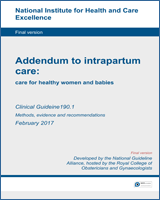From: Appendix I, GRADE tables

NCBI Bookshelf. A service of the National Library of Medicine, National Institutes of Health.
| Quality assessment | Number of women & baby pairs | Measure of diagnostic accuracy | Quality | |||||||||
|---|---|---|---|---|---|---|---|---|---|---|---|---|
| Number. of studies | Design | Risk of bias | Inconsistency | Indirectness | Imprecision | Other considerations | Sensitivity | Specificity | Positive likelihood ratio | Negative likelihood ratio | ||
| Fetal scalp pH < 7.20 | ||||||||||||
|
1 study | Case series | Very serious1 | No serious inconsistency | Serious2 | No serious imprecision | pH < 7.20 = 2/50 (4%) | 50 |
100% (not calculable [NC])a |
83.33% (72.79 to 88)a |
6.0 (3.19 to 30)a |
0 (NC)a | Very low |
|
1 study | Case series | Serious3 | No serious inconsistency | Very serious4 | No serious imprecision | pH < 7.20 = 19/64 (30%) | 64 |
100% (NC)a |
33.33% (19.56 to 11)a |
1.5 (1.22 to 84)a |
0 (NC)a | Very low |
| Caesarean section | ||||||||||||
|
1 study | Case series | Very serious1 | No serious inconsistency | Serious2 | No serious imprecision | Caesarean sections = 10/50 (20%) | 50 |
60% (29.64 to 36)a |
90% (80.70 to 30)a |
6.0 (2.08 to 29)a |
0.44 (0.21 to 96)a | Very low |
NC not calculable
Calculated by the 2014 NCC-WCH technical team
Unclear whether consecutive women were included. Period of fetal heart rate (FHR) observation following stimulation not reported
Insufficient reporting of population and inclusion and exclusion criteria to assess indirectness
Unclear whether consecutive women were included
Population were unborn babies who had not responded with an acceleration to initial digital scalp stimulation. Included gestational age < 37 weeks and > 42 weeks
From: Appendix I, GRADE tables

NCBI Bookshelf. A service of the National Library of Medicine, National Institutes of Health.